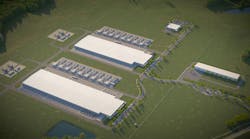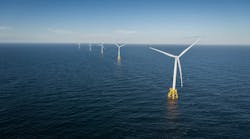The human impact of lighting, further improvements in LED efficiency and solving the problems hamstringing commercialization of OLED lighting are among the top research and development opportunities for solid-state lighting (SSL) identified in a report released this week by the U.S. Department of Energy’s Office of Energy Efficiency & Renewable Energy.
The priorities in the report, titled “2018 Solid-State Lighting R&D Opportunities,” were suggested by members of the U.S. lighting science R&D community who collaborate with the DOE/EERE’s Building Technologies Office (BTO) on its SSL Program.
The report presents a summary of feedback from experts received in roundtable meetings at the OLED Stakeholder meeting and the DOE Solid-State Lighting (SSL) R&D Workshop held in Jan. 2018 in Nashville. The discussions covered foundational R&D needs for both LED and OLED technologies and reflect SSL stakeholder inputs on topics that will improve efficacy, reduce cost, and add value for LED and OLED lighting solutions.
Here are the opportunities sketched out in the report.
Cross-Cutting Lighting R&D (LED and OLED)
• Understanding Human Physiological Impacts of Light to Improve Efficiency – Research to understand and define physiologically optimized lighting for the general population based on objective physiological responses to light and/or large-scale collection and review of subjective responses for the purpose of optimizing lighting efficiency.
• Understanding Lighting Application Efficiency – Develop a general framework, mathematical model, and computer simulation approach to characterize lighting application efficiency for any lighting application in terms of the four primary aspects of lighting application efficiency: light source efficiency, optical delivery efficiency, spectral efficiency, and intensity efficacy.
LED-Based Lighting R&D
• Light Emitting Diode Devices and Materials – Push LED emitters across the visible spectrum that demonstrate advancements in peak efficiency and stable efficiency at high current drive and temperature operating conditions. Also, development of fundamental models to predict LED device performance across a range of materials, device structures, and synthesis techniques.
• Advanced Emitter Device Architectures – Explore the use of advanced emitter device architectures with state-of-art-emitter materials to improve the extraction of white photons from a device package, as measured by overall package power conversion efficiency (lm/W), and the ability to deliver white photons to a target, which generally improves with luminous emittance (lm/mm2).
• Quantum Dot Optical Down-Converters – Research to advance understanding in high efficiency, on-chip quantum dot (QD) down converters to match or exceed performance of conventional on-chip phosphor materials at a range of emission wavelengths.
• Advanced LED Lighting Concepts – Develop fully optimized color-mixed direct LED lighting product concepts that demonstrate efficiency advancements or lighting products with advancements in lighting application efficiency.
• LED Power and Functional Electronics – Develop advanced prototype power delivery concepts for luminaires with high efficiency across the operating range, high reliability and minimal size and weight.
• Additive Fabrication Technologies for Lighting – Develop high volume additive manufacturing technologies for any portion of the LED lighting manufacturing value chain that reduce part count and are cost effective.
OLED-Based Lighting R&D
• Stable, Efficient White Devices – Develop novel materials and structures that can help create a highly efficient, stable white OLED device.
• Advanced Fabrication Technology for OLEDs – Develop novel approaches and advancements in materials deposition, device fabrication, or encapsulation of OLED panels that lead to significant reduction in processing costs without degrading performance.
• Light Extraction and Utilization – Devise new optical and device designs for improving OLED light extraction while retaining the thin profile and advancing state-of-the-art performance of OLED panels.
• OLED Prototype Lighting Platforms – Develop OLED lighting platforms that achieve the performance and design goals of OLED lighting technology and demonstrate clear differentiation from existing products.









